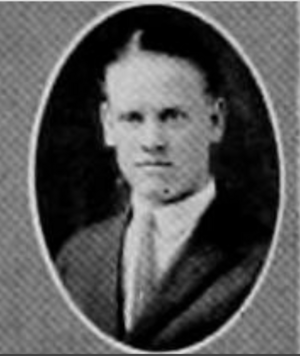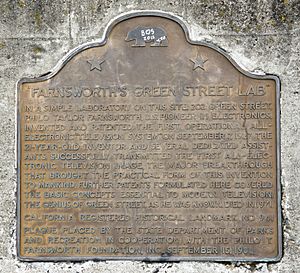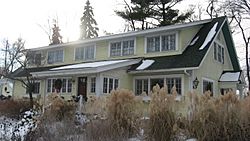Philo Farnsworth facts for kids
Quick facts for kids
Philo Farnsworth
|
|
|---|---|
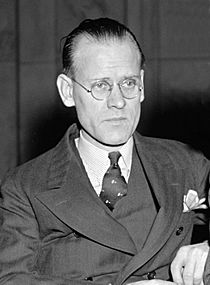
Farnsworth in 1939
|
|
| Born |
Philo Taylor Farnsworth
August 19, 1906 Beaver, Utah, US
|
| Died | March 11, 1971 (aged 64) Holladay, Utah, US
|
| Resting place | Provo City Cemetery, Provo, Utah, US |
| Employer | Philco, Farnsworth Television and Radio Corporation, International Telephone and Telegraph |
| Known for | Inventor of the first fully electronic television; over 169 United States and foreign patents |
| Spouse(s) | Elma "Pem" Gardner (1908–2006) |
| Children | 4 sons |
| Relatives | Agnes Ann Farnsworth (sister) |
Philo Taylor Farnsworth (born August 19, 1906 – died March 11, 1971) was an American inventor. He is known as a pioneer in the early days of television. He made many important discoveries that helped create the first all-electronic television.
Farnsworth is famous for inventing the first fully electronic device to capture images, called the image dissector, in 1927. He also created the first complete electronic television system. His company, Farnsworth Television and Radio Corporation, made and sold these television systems from 1938 to 1951.
Later in his life, Farnsworth invented a small device for nuclear fusion, called the Farnsworth–Hirsch fusor. While it wasn't used to create nuclear power, it was useful for making neutrons. Farnsworth held 300 patents, mostly for his work in radio and television.
Contents
Early Life and Education
Philo Farnsworth was born on August 19, 1906, in a small log cabin in Beaver, Utah. He was the oldest of five children. In 1918, his family moved to a ranch in Rigby, Idaho.
Philo was excited to find that their new home had electricity. He quickly learned about electrical technology. He even fixed a broken electric motor and turned his mother's hand-powered washing machine into an electric one. He became very interested in electronics after finding many technology magazines in the attic.
How Philo Got the Idea for Electronic TV
Farnsworth was a great student in chemistry and physics at Rigby High School. He once asked his science teacher, Justin Tolman, for advice about an electronic television system he was thinking about. He drew many diagrams on the blackboard to show how it could work electronically. Tolman encouraged him to develop his ideas.
One of these drawings was later used in a legal case between Farnsworth and RCA. It helped prove that Farnsworth had the idea first.
In 1923, his family moved to Provo, Utah. Philo attended Brigham Young High School. After his father passed away in 1924, Philo took on the responsibility of supporting his family. He graduated from high school in June 1924.
He briefly joined the United States Naval Academy. However, he learned that the government would own his patents if he stayed in the military. Since he wanted to work on his television ideas, he left the Navy after a few months. He then went to Brigham Young University and continued his research.
While in college, he met Elma "Pem" Gardner, who he later married. Philo and Pem moved to Berkeley, California, in 1926. There, he applied for his first television patent.
Developing Electronic Television
In California, Farnsworth showed his ideas to a patent lawyer. He wanted to make sure his designs were protected. At that time, most television systems used mechanical parts, like spinning disks, to scan images. Farnsworth realized that an all-electronic system would create a much better picture.
First Electronic Image Transmission
On September 7, 1927, Farnsworth's image dissector camera tube sent its first image. It was a simple straight line. This happened in his laboratory at 202 Green Street in San Francisco. Pem Farnsworth later remembered that Philo said, "There you are – electronic television!"
By 1928, Farnsworth's system was good enough for a public demonstration. His supporters wanted to see results, so the first image shown was a dollar sign! In 1929, he improved the system so it had no mechanical parts at all. That year, he also sent the first live images of people, including his wife Pem.
Many inventors had worked on television before Farnsworth. But he designed and built the world's first working all-electronic television system. He showed his system to the public at the Franklin Institute in Philadelphia on August 25, 1934.
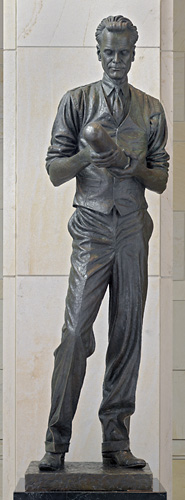
Battles Over Patents
In 1930, another company, RCA, hired Vladimir Zworykin. He had also been trying to develop an electronic television system. Zworykin visited Farnsworth's lab and was impressed.
In 1931, David Sarnoff of RCA offered to buy Farnsworth's patents for $100,000. He also wanted Farnsworth to work for RCA, but Farnsworth refused. RCA then sued Farnsworth, claiming Zworykin's earlier patent was more important.
However, Farnsworth won the case in 1934. The U.S. Patent Office decided that Farnsworth was the true inventor of the image dissector. RCA appealed but lost again. Eventually, RCA agreed to pay Farnsworth royalties for using his inventions.
In 1932, Farnsworth traveled to England. He met John Logie Baird, a Scottish inventor who had shown the first working television system in 1926. Baird's system was mechanical, and he was looking to develop electronic receivers.
In 1938, Farnsworth started the Farnsworth Television and Radio Corporation in Fort Wayne, Indiana. In 1939, after a long legal fight, RCA finally agreed to pay Farnsworth $1 million for a license to use his television patents. This allowed RCA to sell electronic television cameras to the public.
Later Work and Legacy
In 1951, International Telephone and Telegraph (ITT) bought Farnsworth Television and Radio Corporation. While at ITT, Farnsworth continued to invent. He worked on things like early warning signals for defense, submarine detection, and an infrared telescope.
One of his important contributions at ITT was the PPI Projector. This improved radar displays, helping with safe air traffic control. This system was a step towards today's air traffic control systems.
Nuclear Fusion Research
ITT also agreed to fund Farnsworth's research into nuclear fusion. He and his team invented devices called "fusors." These devices could create fusion reactions, but they only lasted for about thirty seconds.
In 1965, ITT decided to stop funding the expensive fusion project. The stress of this decision caused Farnsworth to become ill. In 1967, Farnsworth and his family moved back to Utah. He continued his fusion research at Brigham Young University.
However, his new company, Philo T. Farnsworth Associates (PTFA), struggled to find enough money. By 1970, they had run out of funds. Farnsworth became very ill with pneumonia and passed away on March 11, 1971.
Farnsworth's Wife and His Legacy
Farnsworth's wife, Elma "Pem" Gardner Farnsworth, worked for decades after his death to make sure he was recognized for his inventions. Farnsworth always said that he and Pem started television together. She passed away in 2006 at age 98.
In 1999, Time magazine included Farnsworth in its list of "The Most Important People of the Century."
Key Inventions
Electronic Television System
Farnsworth first thought of the idea for his image dissector in 1921, when he was almost 15 years old. He showed the first working version on September 7, 1927. His idea for scanning an image line by line came from watching how a farmer plows a field.
The video camera tube that came from the work of Farnsworth and others was used in all television cameras until the late 20th century. Farnsworth also created the "image oscillite," which was a cathode ray tube that showed the images captured by his image dissector. He called his device an image dissector because it broke down the image into tiny pieces and turned them into electricity one by one.
In 1984, Farnsworth was added to the National Inventors Hall of Fame.
The Fusor
The Farnsworth–Hirsch fusor is a machine designed by Farnsworth to create nuclear fusion. Unlike other fusion systems that slowly heat a gas, the fusor shoots hot ions directly into a reaction chamber.
When the fusor was first shown in the 1960s, it was the first device that could clearly show it was producing fusion reactions. While it hasn't become a practical power source, the fusor is now used as a neutron source and is sold commercially.
Other Important Inventions
When he died, Farnsworth held 300 patents in the U.S. and other countries. His inventions helped develop radar, infra-red night vision devices, the electron microscope, and the astronomical telescope.
TV Appearance
Even though he invented electronic television, Farnsworth only appeared on a TV program once. On July 3, 1957, he was a mystery guest on the CBS quiz show I've Got A Secret. He answered questions as the panel tried to guess his secret: "I invented electronic television."
He explained that his invention removed the moving parts from older television systems. He made the whole thing electronic. He also mentioned that thousands of inventions were important to television. Farnsworth talked about his current research, including trying to create clearer pictures with more lines and flat-screen TVs.
Honors and Memorials
Honors for Philo Farnsworth
- In 1967, Brigham Young University gave Farnsworth an honorary degree.
- In 2006, he was given the Eagle Scout award after it was found he had earned it but never received it.
- He was added to the Broadcast Pioneers of Philadelphia Hall of Fame in 2006.
- In 2013, he was inducted into the Television Academy Hall of Fame.
Places and Things Remembering Farnsworth
- A bronze statue of Farnsworth represents Utah in the National Statuary Hall Collection in the United States Capitol building.
- Another statue is inside the Utah State Capitol in Salt Lake City.
- A plaque in Wyndmoor, Pennsylvania, marks where Farnsworth worked on television in the 1930s.
- In San Francisco, a plaque honors Farnsworth as The Genius of Green Street at his former lab location.
- The Letterman Digital Arts Center in San Francisco has a statue of Farnsworth.
- A plaque is located next to his former home in Fort Wayne, Indiana.
- Farnsworth is honored with a plaque in Walt Disney World's "Inventor's Circle" at EPCOT.
- A 1983 United States postage stamp honored Farnsworth.
- In 2011, Farnsworth was inducted into the San Francisco Hall of Fame.
- His television work and an original TV tube are on display at the Farnsworth TV & Pioneer Museum in Rigby, Idaho.
Things Named After Farnsworth
- The Philo T. Farnsworth Award is given to companies that have greatly impacted television and broadcast engineering.
- The Philo Awards are an annual competition for public-access television in the Ohio, Indiana, Kentucky, and Michigan region.
- Philo, a streaming television company, is named after him.
- Farnsworth Peak in Utah is named after him. It is home to many television and FM radio transmitters.
- The Philo T. Farnsworth Elementary School in Rigby, Idaho, is named in his honor.
Fort Wayne and Marion Sites
In 2010, the old Farnsworth factory in Fort Wayne, Indiana, was taken down. This factory was where many of his inventions were first made. It also produced radios, televisions, and phonographs.
Farnsworth's home in Fort Wayne from 1948 to 1967 is now a historical site. It is recognized by an Indiana state historical marker.
Farnsworth also had a factory in Marion, Indiana. This factory made shortwave radios used by American soldiers during World War II.
Patents
- U.S. Patent 1,773,980 : Television system (filed January 7, 1927, issued August 26, 1930)
- U.S. Patent 1,773,981: Television receiving system (filed January 7, 1927, issued August 26, 1930)
- U.S. Patent 1,758,359: Electric oscillator system (filed January 7, 1927, issued May 13, 1930)
- U.S. Patent 1,806,935: Light valve (filed January 7, 1927, issued May 26, 1931)
- U.S. Patent 2,168,768: Television method (filed January 9, 1928, issued August 8, 1939)
- U.S. Patent 1,970,036: Photoelectric apparatus (filed January 9, 1928, issued August 14, 1934)
- U.S. Patent 2,246,625: Television scanning and synchronization system (filed May 5, 1930, issued June 24, 1941)
- U.S. Patent 1,941,344: Dissector target (filed July 7, 1930, issued December 26, 1933)
- U.S. Patent 2,140,284: Projecting oscillight (filed July 14, 1931, issued December 13, 1938)
- U.S. Patent 2,059,683: Scanning oscillator (filed April 3, 1933, issued November 3, 1936)
- U.S. Patent 2,087,683: Image dissector (filed April 26, 1933, issued July 20, 1937)
- U.S. Patent 2,071,516: Oscillation generator (filed July 5, 1934, issued February 23, 1937)
- U.S. Patent 2,143,145: Projection means (filed November 6, 1934, issued January 10, 1939)
- U.S. Patent 2,233,887: Image projector (filed February 6, 1935, issued March 4, 1941)
- U.S. Patent 2,143,262: Means of electron multipaction (filed March 12, 1935, issued January 10, 1939)
- U.S. Patent 2,174,488: Oscillator (filed March 12, 1935, issued September 26, 1939)
- U.S. Patent 2,221,473: Amplifier (filed March 12, 1935, issued November 12, 1940)
- U.S. Patent 2,155,478: Means for producing incandescent images (filed May 7, 1935, issued April 25, 1939)
- U.S. Patent 2,140,695: Charge storage dissector (filed July 6, 1935, issued December 20, 1938)
- U.S. Patent 2,228,388: Cathode ray amplifier (filed July 6, 1935, issued January 14, 1941)
- U.S. Patent 2,233,888: Charge storage amplifier (filed July 6, 1935, issued March 4, 1941)
- U.S. Patent 2,251,124: Cathode ray amplifying tube (filed August 10, 1935, issued July 29, 1941)
- U.S. Patent 2,100,842: Charge storage tube (filed September 14, 1935, issued November 30, 1937)
- U.S. Patent 2,137,528: Multipactor oscillator (filed January 27, 1936, issued November 22, 1938)
- U.S. Patent 2,214,077: Scanning current generator (filed February 10, 1936, issued September 10, 1940)
- U.S. Patent 2,089,054 : Incandescent light source (filed March 9, 1936, issued August 3, 1937)
- U.S. Patent 2,159,521: Absorption oscillator (filed March 9, 1936, issued May 23, 1939)
- U.S. Patent 2,139,813: Secondary emission electrode (filed March 24, 1936, issued December 13, 1938)
- U.S. Patent 2,204,479: Means and method for producing electronic multiplication (filed May 16, 1936, issued June 11, 1940)
- U.S. Patent 2,140,832: Means and method of controlling electron multipliers (filed May 16, 1936, issued December 20, 1938)
- U.S. Patent 2,260,613: Electron multiplier (filed May 18, 1936, issued October 28, 1941)
- U.S. Patent 2,141,837 : Multistage multipactor (filed June 1, 1936, issued December 27, 1938)
- U.S. Patent 2,216,265: Image dissector (filed August 18, 1936, issued October 1, 1940)
- U.S. Patent 2,128,580: Means and method of operating electron multipliers (filed August 18, 1936, issued August 30, 1938)
- U.S. Patent 2,143,146: Repeater (filed October 31, 1936, issued January 10, 1939)
- U.S. Patent 2,139,814: Cathode ray tube (filed November 2, 1936, issued December 13, 1938)
- U.S. Patent 2,109,289: High power projection oscillograph (filed November 2, 1936, issued February 22, 1938)
- U.S. Patent 2,184,910: Cold cathode electron discharge tube (filed November 4, 1936, issued December 26, 1939)
- U.S. Patent 2,179,996: Electron multiplier (filed November 9, 1936, issued November 14, 1939)
- U.S. Patent 2,221,374: X-ray projection device
- U.S. Patent 2,263,032: Cold cathode electron discharge tube
- U.S. Patent 3,258,402: Electric discharge device for producing interaction between nuclei
- U.S. Patent 3,386,883: Method and apparatus for producing nuclear fusion reactions
- U.S. Patent 3,664,920: Electrostatic containment in fusion reactors
See also
 In Spanish: Philo Farnsworth para niños
In Spanish: Philo Farnsworth para niños


